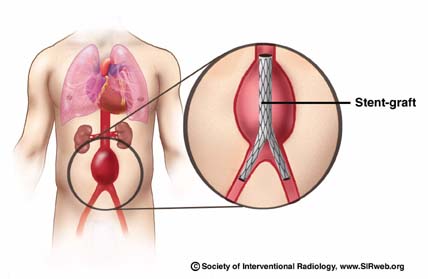Interventional Repair - Stent Graft
This minimally invasive technique is performed by an interventional radiologist using imaging to guide the catheter and graft inside the patient's artery. For the procedure, an incision is made in the skin at the groin through which a catheter is passed into the femoral artery and directed to the aortic aneurysm. Through the catheter, the physician passes a stent graft that is compressed into a small diameter within the catheter. The stent graft is advanced to the aneurysm, then opened, creating new walls in the blood vessel through which blood flows.
This is a less invasive method of placing a graft within the aneurysm to redirect blood flow and stop direct pressure from being exerted on the weak aortic wall. This relatively new method eliminates the need for a large abdominal incision. It also eliminates the need to clamp the aorta during the procedure. Clamping the aorta creates significant stress on the heart, and people with severe heart disease may not be able to tolerate this major surgery. Stent grafts are most commonly considered for patients at increased surgical risk due to age or other medical conditions.
The stent graft procedure is not for everyone, though. It is still a new technology and we don't yet have data to show that this will be a durable repair for long years. Thus, people with a life expectancy of 20 or more years may be counseled against this therapy. It is also a technology that is limited by size. The stent grafts are made in certain sizes, and the patient's anatomy must fit the graft, since grafts are not custom-built for each patient's anatomy.

A stent-graft is threaded into the blood vessel where the aneurysm is located. The stent graft is expanded like a spring to hold tightly against the wall of the blood vessel and cut off the blood supply to the aneurysm.
Efficacy and Patient Safety
Interventional repair is an effective treatment that can be performed safely, resulting in lower morbidity and lower mortality rates than those reported for open surgical repair.
Recovery Time
Patients are often discharged the day after interventional repair, and typically do not require intensive care stay post-op.
Once discharged, most return to normal activity within 2 weeks compared to 6-8 weeks after surgical repair.
Benefits of Interventional Repair
- No abdominal surgical incision
- No sutures, or sutures only at the groins
- Faster recovery, shorter time in the hospital
- No general anesthesia in some cases
- Less pain
- Reduced complications
Interventional Radiologists are Vascular Disease Experts
Interventional radiology is a recognized medical specialty by the American Board of Medical Specialties. Interventional radiologists are board-certified physicians with extensive training in vascular disease diagnosis, management and treatment. Their board certification includes both Vascular and Interventional Radiology and Diagnostic Radiology which are administered by the American Board of Radiology. This training marries state-of-the-art imaging and diagnostic expertise, coupled with clinical experience across all specialties and in-depth knowledge of the least invasive treatments.
Conditions treated include Abdominal Aortic Aneurysms AAA.


